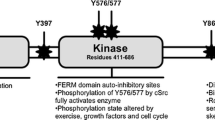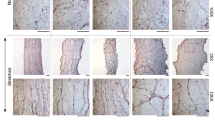Abstract
We examined the involvement of focal adhesion kinase (FAK) in mechano-regulated signalling to protein synthesis by combining muscle-targeted transgenesis with a physiological model for un- and reloading of hindlimbs. Transfections of mouse tibialis anterior muscle with a FAK expression construct increased FAK protein 1.6-fold versus empty transfection in the contralateral leg and elevated FAK concentration at the sarcolemma. Altered activation status of phosphotransfer enzymes and downstream translation factors showed that FAK overexpression was functionally important. FAK auto-phosphorylation on Y397 was enhanced between 1 and 6 h of reloading and preceded the activation of p70S6K after 24 h of reloading. Akt and translation initiation factors 4E-BP1 and 2A, which reside up- or downstream of p70S6K, respectively, showed no FAK-modulated regulation. The findings identify FAK as an upstream element of the mechano-sensory pathway of p70S6K activation whose Akt-independent regulation intervenes in control of muscle mass by mechanical stimuli in humans.






Similar content being viewed by others
References
Akimoto K, Nakaya M, Yamanaka T, Tanaka J, Matsuda S, Weng QP, Avruch J, Ohno S (1998) Atypical protein kinase Clambda binds and regulates p70 S6 kinase. Biochem J 335(Pt 2):417–424
Baar K, Esser K (1999) Phosphorylation of p70(S6k) correlates with increased skeletal muscle mass following resistance exercise. Am J Physiol 276:C120–C127
Baar K, Nader G, Bodine S (2006) Resistance exercise, muscle loading/unloading and the control of muscle mass. Essays Biochem 42:61–74
Bodine SC, Stitt TN, Gonzalez M, Kline WO, Stover GL, Bauerlein R, Zlotchenko E, Scrimgeour A, Lawrence JC, Glass DJ, Yancopoulos GD (2001) Akt/mTOR pathway is a crucial regulator of skeletal muscle hypertrophy and can prevent muscle atrophy in vivo. Nat Cell Biol 3:1014–1019
Burry M, Hawkins D, Spangenburg EE (2007) Lengthening contractions differentially affect p70(s6k) phosphorylation compared to isometric contractions in rat skeletal muscle. Eur J Appl Physiol 100:409–415
Carlson CJ, Booth FW, Gordon SE (1999) Skeletal muscle myostatin mRNA expression is fiber-type specific and increases during hindlimb unloading. Am J Physiol 277:R601–R606
Cary LA, Guan JL (1999) Focal adhesion kinase in integrin-mediated signaling. Front Biosci 4:D102–D113
Chan TO, Rittenhouse SE, Tsichlis PN (1999) AKT/PKB and other D3 phosphoinositide-regulated kinases: kinase activation by phosphoinositide-dependent phosphorylation. Annu Rev Biochem 68:965–1014
Chiquet M, Flück M (2002) Early responses to mechanical stress: from signals at the cell surface to altered gene expression. In: Storey KB, Storey JM (eds) Protein adaptations and signal transduction. Elsevier Science, BV, pp 97–109
Dapp C, Schmutz S, Hoppeler H, Fluck M (2004) Transcriptional reprogramming and ultrastructure during atrophy and recovery of mouse soleus muscle. Physiol Genomics 20:97–107
Dardevet D, Sornet C, Vary T, Grizard J (1996) Phosphatidylinositol 3-kinase and p70 s6 kinase participate in the regulation of protein turnover in skeletal muscle by insulin and insulin-like growth factor I. Endocrinology 137:4087–4094
Deldicque L, Atherton P, Patel R, Theisen D, Nielens H, Rennie MJ, Francaux M (2008) Decrease in Akt/PKB signalling in human skeletal muscle by resistance exercise. Eur J Appl Physiol 104:57–65
Durieux AC, Bonnefoy R, Manissolle C, Freyssenet D (2002) High-efficiency gene electrotransfer into skeletal muscle: description and physiological applicability of a new pulse generator. Biochem Biophys Res Commun 296:443–450
Durieux AC, Bonnefoy R, Busso T, Freyssenet D (2004) In vivo gene electrotransfer into skeletal muscle: effects of plasmid DNA on the occurrence and extent of muscle damage. J Gene Med 6:809–816
Durieux AC, Desplanches D, Freyssenet D, Fluck M (2007) Mechanotransduction in striated muscle via focal adhesion kinase. Biochem Soc Trans 35:1312–1313
Eliasson J, Elfegoun T, Nilsson J, Kohnke R, Ekblom B, Blomstrand E (2006) Maximal lengthening contractions increase p70 S6 kinase phosphorylation in human skeletal muscle in the absence of nutritional supply. Am J Physiol Endocrinol Metab 291:E1197–E1205
Fluck M, Hoppeler H (2003) Molecular basis of skeletal muscle plasticity—from gene to form and function. Rev Physiol Biochem Pharmacol 146:159–216
Fluck M, Waxham MN, Hamilton MT, Booth FW (2000) Skeletal muscle Ca(2+)-independent kinase activity increases during either hypertrophy or running. J Appl Physiol 88:352–358
Fluck M, Ziemiecki A, Billeter R, Muntener M (2002) Fibre-type specific concentration of focal adhesion kinase at the sarcolemma: influence of fibre innervation and regeneration. J Exp Biol 205:2337–2348
Fluck M, Schmutz S, Wittwer M, Hoppeler H, Desplanches D (2005) Transcriptional reprogramming during reloading of atrophied rat soleus muscle. Am J Physiol Regul Integr Comp Physiol 289:R4–R14
Fluck M, Mund SI, Schittny JC, Klossner S, Durieux AC, Giraud MN (2008) Mechano-regulated Tenascin-C orchestrates muscle repair. Proc Natl Acad Sci USA 105:13662–13667
Flück M, Carson JA, Gordon SE, Ziemiecki A, Booth FW (1999) Focal adhesion proteins FAK and paxillin increase in hypertrophied skeletal muscle. Am J Physiol 277:C152–C162
Fujita S, Abe T, Drummond MJ, Cadenas JG, Dreyer HC, Sato Y, Volpi E, Rasmussen BB (2007) Blood flow restriction during low-intensity resistance exercise increases S6K1 phosphorylation and muscle protein synthesis. J Appl Physiol 103:903–910
Gan B, Yoo Y, Guan JL (2006) Association of focal adhesion kinase with tuberous sclerosis complex 2 in the regulation of s6 kinase activation and cell growth. J Biol Chem 281:37321–37329
Gehl J, Sorensen TH, Nielsen K, Raskmark P, Nielsen SL, Skovsgaard T, Mir LM (1999) In vivo electroporation of skeletal muscle: threshold, efficacy and relation to electric field distribution. Biochim Biophys Acta 1428:233–240
Gingras AC, Raught B, Sonenberg N (2001) Regulation of translation initiation by FRAP/mTOR. Genes Dev 15:807–826
Gordon SE, Fluck M, Booth FW (2001) Selected contribution: skeletal muscle focal adhesion kinase, paxillin, and serum response factor are loading dependent. J Appl Physiol 90:1174–1183
Hemmings BA (1997) Akt signaling: linking membrane events to life and death decisions. Science 275:628–630
Hunter T (2000) Signaling—2000 and beyond. Cell 100:113–127
Ingber DE (2006) Cellular mechanotransduction: putting all the pieces together again. FASEB J 20:811–827
Isotani S, Hara K, Tokunaga C, Inoue H, Avruch J, Yonezawa K (1999) Immunopurified mammalian target of rapamycin phosphorylates and activates p70 S6 kinase alpha in vitro. J Biol Chem 274:34493–34498
Kimball SR, Horetsky RL, Jefferson LS (1998) Signal transduction pathways involved in the regulation of protein synthesis by insulin in L6 myoblasts. Am J Physiol 274:C221–C228
Kimball SR, O’Malley JP, Anthony JC, Crozier SJ, Jefferson LS (2004) Assessment of biomarkers of protein anabolism in skeletal muscle during the life span of the rat: sarcopenia despite elevated protein synthesis. Am J Physiol Endocrinol Metab 287:E772–E780
Laser M, Kasi VS, Hamawaki M, Cooper G, Kerr CM, Kuppuswamy D (1998) Differential activation of p70 and p85 S6 kinase isoforms during cardiac hypertrophy in the adult mammal. J Biol Chem 273:24610–24619
Malik RK, Parsons JT (1996) Integrin-dependent activation of the p70 ribosomal S6 kinase signaling pathway. J Biol Chem 271:29785–29791
Nader GA, Esser KA (2001) Intracellular signaling specificity in skeletal muscle in response to different modes of exercise. J Appl Physiol 90:1936–1942
Napoli R, Gibson L, Hirshman MF, Boppart MD, Dufresne SD, Horton ES, Goodyear LJ (1998) Epinephrine and insulin stimulate different mitogen-activated protein kinase signaling pathways in rat skeletal muscle. Diabetes 47:1549–1554
Pallafacchina G, Calabria E, Serrano AL, Kalhovde JM, Schiaffino S (2002) A protein kinase B-dependent and rapamycin-sensitive pathway controls skeletal muscle growth but not fiber type specification. Proc Natl Acad Sci USA 99:9213–9218
Pullen N, Thomas G (1997) The modular phosphorylation and activation of p70s6k. FEBS Lett 410:78–82
Rennie MJ (2007) Exercise- and nutrient-controlled mechanisms involved in maintenance of the musculoskeletal mass. Biochem Soc Trans 35:1302–1305
Reynolds TH, Bodine SC, Lawrence JC Jr (2002) Control of Ser2448 phosphorylation in the mammalian target of rapamycin by insulin and skeletal muscle load. J Biol Chem 277:17657–17662
Romer LH, Birukov KG, Garcia JG (2006) Focal adhesions: paradigm for a signaling nexus. Circ Res 98:606–616
Sale EM, Atkinson PP, Arnott CH, Chad JE, Sale GJ (1999) Role of ERK1/ERK2 and p70S6K pathway in insulin signalling of protein synthesis. FEBS Lett 446:122–126
Samarel AM (2005) Costameres, focal adhesions, and cardiomyocyte mechanotransduction. Am J Physiol Heart Circ Physiol 289:H2291–H2301
Sandri M (2008) Signaling in muscle atrophy and hypertrophy. Physiology 23:160–170
Spangenburg EE, LeRoith D, Ward CW, Bodine S (2008) A functional insulin-like growth factor receptor is not necessary for load-induced skeletal muscle hypertrophy. J Physiol 586:283–291
Terzis G, Georgiadis G, Stratakos G, Vogiatzis I, Kavouras S, Manta P, Mascher H, Blomstrand E (2008) Resistance exercise-induced increase in muscle mass correlates with p70S6 kinase phosphorylation in human subjects. Eur J Appl Physiol 102:145–152
Thomas G, Hall MN (1997) TOR signalling and control of cell growth. Curr Opin Cell Biol 9:782–787
Thomson DM, Gordon SE (2006) Impaired overload-induced muscle growth is associated with diminished translational signalling in aged rat fast-twitch skeletal muscle. J Physiol 574:291–305
Acknowledgments
Special thanks are addressed to the personal of the University of Berne: PhD Sonja Mund and David Haberthür for their work in breeding and housing the animals. We also acknowledge the assistance of PhD Michael Altmann from the Institute for Biochemistry and Molecular Biology and PhD Jürg Reichen from the Department of Clinical Pharmacology and PhD Oliver Baum from the Institute of Anatomy for their technical advices. This study was supported by the Swiss National Science Foundation and a start up grant from the Manchester Metropolitan University.
Author information
Authors and Affiliations
Corresponding author
Rights and permissions
About this article
Cite this article
Klossner, S., Durieux, AC., Freyssenet, D. et al. Mechano-transduction to muscle protein synthesis is modulated by FAK. Eur J Appl Physiol 106, 389–398 (2009). https://doi.org/10.1007/s00421-009-1032-7
Accepted:
Published:
Issue Date:
DOI: https://doi.org/10.1007/s00421-009-1032-7




